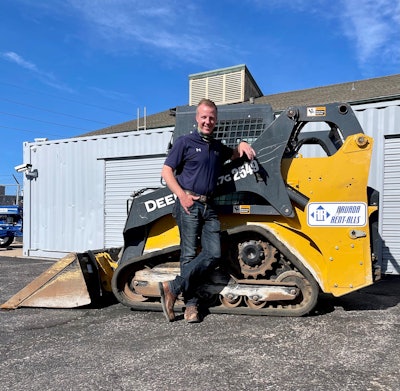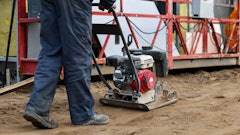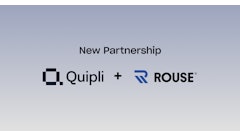
When Andrew Heesacker came to Arvada Rent-Alls in 2013, the company’s customer base heavily consisted of homeowners, with the company providing rentals on service items such as lawn mowers and snow blowers.
Heesacker’s father had owned the business since 1986, and while Heesacker had gained several years of experience through high school and during college, he deems the job he got after college at Neff Rental (from 2007 to 2013) in Florida as his “official” start in the rental industry.
At Neff Rental, which geared most of its business toward contractors and heavy earth-moving equipment, Heesacker spent six years working in different sales and management positions.
So, when Heesacker, now president and CEO Arvada Rent-Alls, made the move to Colorado to take over from his father as a second-generation owner, he had a different vision for where the company should be headed.
“My vision at that point was more centered around contractors,” Heesacker says. “So, through the years, I built up systems and put the pieces to the puzzle together trying to streamline operations.”
Heesacker explains how his company made the switch and offers advice for other rental companies looking to maximize efficiency at their operations.
Where it began
When Heesacker started as the newbie owner in 2013, he inherited a very tenured staff, with some employees having been with the company for 25 to 30 years.
At first, he encountered some resistance to the changes he had planned to make—such as shifting the sales process from handwritten tickets to putting them directly into the point-of-sale software that the company had recently onboarded.
“The reaction I got was not great at first, and a lot of people had the perspective of ‘why would we do this? We don’t need to do this',” Heesacker says. “At that moment, I realized that patience was going to have to be a very forthright thing if I was going to get the buy-in of a lot of those tenured employees.”
Now 10 years out from that changeover, Heesacker says several of those tenured employees are still with the company, with a handful of them having already retired from the company.
“In addition to being patient and getting the buy-in, I learned that I really had to actively listen to people, take their ideas and make them feel heard,” Heesacker says. “So, for example, using time cards instead of manually calculating hours, I presented the idea and let it marinate for a bit of time. Then, when we implemented it, we listened to whether there was a way we can make things even easier from there.”
When it came to shifting the company to larger equipment, Heesacker acknowledges that it was a big decision—not a jump to make without a lot of forethought.
“Once you make that commitment, you have to go all in and you have to have the stomach for it,” Heesacker says. “Because the minute you start talking about equipment that weighs more than 10,000 pounds and that’s valued at more than $50,000, you really open a Pandora’s box. You have to have specific mechanics, you have to have the trucks and trailers to safely transport everything, you have to have educated salespeople and there are insurance requirements to think of.”
Heesacker points to the American Rental Association as having many resources to help guide rental companies through that process.
“In the end, it’s knowing that there is still a very specific need for independent rental centers, or mom-and-pop rental centers, throughout the country,” Heesacker says. “Even some of the largest contractors prefer to use an independent, locally owned rental store, so there’s still a lot of opportunity out there.”
Tech talk
Automated clock-in cards were just the beginning as far as new technology the company incorporated.
From the start, the company used two separate software systems: Alert Software and Charter Software.
“We would actually process the invoices in the point-of-sale system, and then we had an actual cash register where we would bring all the revenue through, so every dollar actually got written into the cash register,” Heesacker says. “Basically, we were doing double work, and it never really balanced because the more things you have to do, the more chance there is for human error.”
Heesacker says that some transactions were processed through Alert, while others were processed through Charter.
Heesacker soon realized that in this case, two systems were not better than one and brought the issue to his staff that all of the functionalities of Charter could actually be done through Alert.
“I had to show them all that doing that would make the backend accounting and office calculations a lot easier,” Heesacker says.
For other rental companies interested in implementing a new software, Heesacker recommends leaning on the software provider for help.
“A lot of times, they have user conferences or trainings that they offer, or they will actually come to your site and do hands-on training,” Heesacker says.
Once staff members have gone through training, that’s when a company can really make sure the software is working for it in the best way possible, Heesacker says.
“Once you get the kinks ironed out and learn how to use the system, you can figure out the shortcuts and start using it to its full potential,” Heesacker says. “At first, it can be very daunting to switch, but once you start getting it figured out, it only gets easier.”
With other types of technology, such as that included on equipment, Heesacker says his staff is curious about it but isn’t jumping to be the first to onboard it.
“For us as an entire unit, we will let the larger companies get the technology on larger classes of equipment figured out first,” Heesacker says. “But with the smaller equipment, we take the burden of that risk by trying to figure out how exactly it’s going to affect the end user and how the end user is going to use it properly.”
Contending with challenges
Like many other rental companies, Arvada Rent-Alls has had its fair share of challenges, especially with the current market.
Lead times are one particular challenge.
“Lead times have been one of the most prolific challenges that I've seen in the 15 years that I've been in the industry,” Heesacker says. “Not being able to put your orders in for equipment for a year or sometimes two years out has been very challenging.”
He adds that the volatility of rising prices of equipment and interest rates have also proven to be challenges as of late.
However, Heesacker says Arvada Rent-Alls combats these challenges by being strategic and evaluating each equipment decision based on historical data.
“Tracking missed rentals helps—you can do it the old-fashioned way with a spreadsheet or with a point-of-sales rental software,” Heesacker says. “Either way, that will help guide you in terms of where you need to put your dollars to have the most impact.”
And, of course, like many other companies, the labor strain is no stranger to Arvada Rent-Alls, but overall, Heesacker says the company has been able to keep its staff and has a low turnover rate.
So how does the company do it?
“When talking about culture, a lot of times, people think about pizza parties or beanbag chairs or especially money,” Heesacker says. “However, I’ve had a lot more impact with our employees with consistent feedback.”
To achieve this, the company runs on a quarterly system where it has a state-of-the-company meeting so that everyone is on the same page and there’s clarity into what the organization is doing.
After that, the company holds one-on-one meetings with everyone within the company.
“A lot of companies do a yearly performance review, but we found that’s just not as effective,” Heesacker says. “With quarterly reviews, it keeps everything fresh and helps us because the human brain really only thinks in a 90-day increment anyway. We found it extremely effective to set goals in 90-day chunks and to touch base on areas for improvement and areas they’re doing really well.”
The consistent feedback goes both ways, Heesacker says, as the company genuinely requests feedback from employees on how to better the organization.
“If you are an employee, no matter what level—if you're entry level, if you’ve been with us for 25 years, if you’re an outside salesperson or a mechanic, we want to hear from you to try to make the entire thing better,” Heesacker says.
One example of such feedback was employees requesting that weekly meetings became biweekly meetings. Another change within the company came from employees asking that schedules for the next week be sent out on Wednesday instead of Friday.
“Sometimes people can be hesitant to share that type of feedback with supervisors because it doesn’t always work out, but we’ve tried to build that culture where we listen,” Heesacker says. “Those are the types of things we do that gain buy-in from the employees and that have had the most impact in terms of retaining top talent, and then also recruiting.”
Moving forward
In the future, Heesacker says he sees technology continuing to be a major factor in how the rental industry does business.
“Whether it’s battery power, automated equipment, telematics, while the construction and rental industries have lagged a bit behind other industries, it’s starting to catch up,” Heesacker says. “I think we’re going to see a huge uptick in those types of technology.”
He notes that he thinks automation, in particular, will be a game-changer for the industry.
“From a rental perspective, everyone’s equipment breaks at some point, so service calls and the service aspect of the business will have to get a lot more automated and engaging for people, especially as decision-makers become younger and younger,” Heesacker says.
Words of wisdom
“Learn to lead people without being their boss. You don’t get a crown when you become an operations manager or president, and you still have to get people’s buy-in to be a leader.” — Andrew Heesacker
“The worst people can do at the end of the day is say ‘no,’ whether it’s a customer or potential employee. Just be sure to always ask for the opportunity.” — Andrew Heesacker




















